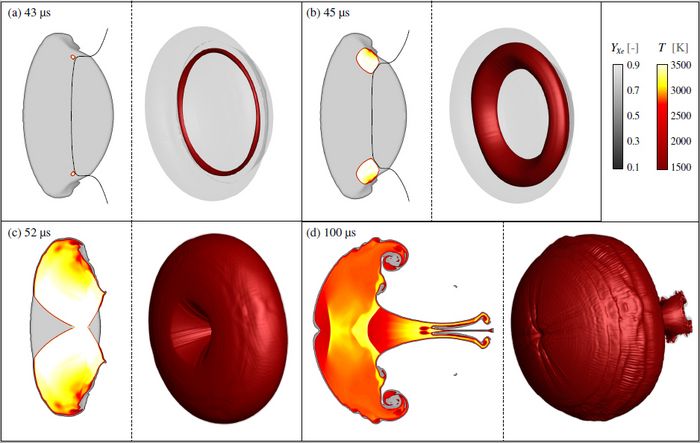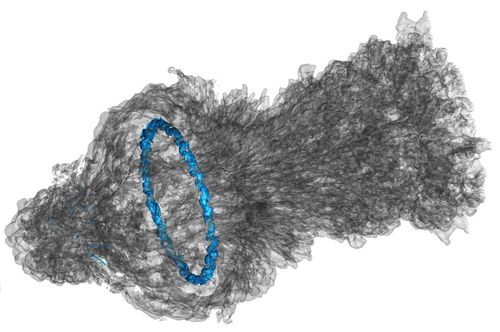ENGINEERING AND CFD
3D Reacting Shock-Bubble Interaction
Principal Investigator:
Nikolaus A. Adams
Affiliation:
Institute of Aerodynamics and Fluid Mechanics, Technische Universität München
Local Project ID:
pr45wa
HPC Platform used:
SuperMUC of LRZ
Date published:
Introduction
The efficient mixing of fuel and oxidizer is essential in modern combustion engines. Especially in supersonic combustion the rapid mixing of fuel and oxidizer is of crucial importance as the detention time of the fuel-oxidizer mixture in the combustion chamber is only a few milliseconds [1]. The shock-induced Richtmyer-Meshkov instability (RMI) promotes mixing and thus has the potential to increase the burning efficiency of supersonic combustion engines [2]. However, the shock wave, necessary to induce RMI, causes a second effect in a reactive gas mixture. The compression and temperature increase over the shock front can ignite the gas mixture, followed by a subsonic deflagration or a supersonic detonation wave. The reaction wave in turn interacts with the RMI, which affects the flow field evolution und the mixing significantly.
Our LRZ project [3] is used for three-dimensional simulations of a reacting shock-bubble interaction (RSBI) to study the interaction between RMI and shock-induced reaction waves. A planar shock wave propagates through a gas bubble filled with a reactive gas mixture. The baroclinic vorticity generated at the interface causes the bubble to evolve into a vortex ring. Upon contact, the incident shock wave is partially reflected and partially transmitted. In our setup of a convergent geometry (a heavy gas bubble surrounded by a light ambient gas) the transmitted shock wave propagates at a lower velocity than the incident shock wave. Hence, the transmitted shock wave is deformed such that it is focused at the downstream pole of the bubble. Pressure and temperature increase at this shock focusing point, which is be sufficient to ignite the gas mixture.
Our setup contains a gas bubble filled with a stoich-iometric composition of Hydrogen (H2), Oxygen (O2) and Xenon, surrounded by pure Nitrogen. The H2-O2 reaction is highly pressure sensitive. Previous two-dimensional studies have already shown promising results by the variation of the initial pressure and the shock Mach number [4,5]. For the three-dimensional study we use a shock Mach number of Ma = 2.83 to trigger detonation. The influence of the reaction wave on the mixing and the spatial evolution of the bubble is studied in detail.
Numerical Method
We use the parallelized numerical framework INCA [6] on the SuperMUC to solve the full set of compressible reacting multicomponent Navier-Stokes equations. The 2nd-order accurate Strang time splitting scheme is used to separate the stiff source term, containing the chemical reaction kinetics, from the Navier-Stokes equations, which results in a system of partial differential equations (PDE) and a system of stiff ordinary differential equations (ODE). The time integration for the PDE system is realized by the 3rd-order total variation diminishing Runge-Kutta scheme. The numerical fluxes at the cell faces are reconstructed from cell averages by the adaptive central-upwind 6th-order weighted essentially non-oscillatory (WENO-CU6) scheme. The 5th-order backward differentiation formula is applied to solve the stiff source term of the ODE, containing the chemical reaction kinetics. A complex H2-O2 reaction mechanism with eight species and 19 intermediate reactions is chosen to provide accurate results.
The simulations are performed at a resolution of 140 points per radius (ppr) in the fine region of the grid, which amounts to a total number of 115 million cells. More than 10.000 cores consumed approximately 5 million CPUh for a single simulation.
Results and Methods
The ignition spot and the propagation of the reaction wave is shown in Fig. 1. Each set of isosurface and isocontour plots contains a two-dimensional slice and a three-dimensional rendering of the RSBI. Figure 1 (a) shows the bubble shortly after ignition. The solid line represents the initial shock wave, propagating from left to right. The gas mixture is ignited directly behind the shock wave after a short induction time and propagates as a combustion ring through the bubble gas. At the early stage of combustion the reaction wave spreads radially in all spatial directions, see Fig. 1 (b). After approximately 10 µs, the reaction wave has consumed most of the bubble gas and a toruslike region of burned gas is formed, which is outlined in Fig. 1 (c). The last set of isosurface and isocontour plots in Fig. 1 (d) shows the RSBI at t = 100 µs. The H2-O2 mixture has been burned, shock reflections cause a complex temperature field inside the bubble and the roll-up with the formation of the main vortex ring is initiated. The propagation of the detonation wave towards the shock-focusing point and the subsequent blow out of bubble gas leads to a characteristic jellyfish-like structure of three-dimensional RSBI.

Figure 1: Ignition and detonation wave propagation in a RSBI with a shock Mach number of Ma = 2.83. For two-dimensional plots: gray color scale shows the xenon mass fraction, red-yellow color scale the temperature with a cutoff at T = 1500 K. Black lines in (a) and (b) depict the initial shock wave, propagating from left to right. For three-dimensional plots: red isosurface depicts the temperature at cutoff level of T = 1500 K, gray isosurface illustrates the bubble shape (YXe = 0.1) [7].
Copyright: Technische Universität MünchenAdditionally we observe that the main vortex ring becomes unstable at late stages. Figure 2 shows the vortex ring at t = 600 µs, destabilized by azimuthal bending modes. Our observations are in very good agreement with the results of Klein et al. [8]. They also observed that their shocked sphere undergoes an azimuthal bending mode instability, which is analogous to the Widnall instability [9]. Furthermore a restriction for the growth of Widnall-type instabilities is observed by Hejazialhosseini et al. [10]. The Atwood numbers has to be larger than 0.2 to induce the azimuthal instability, which is fulfilled in our setup with an Atwood number of A = 0.476. The destabilized vortex ring significantly affects the mixing process at late stages of evolution.
References and Links
[1] Yang, J., Kubota, T., Zukoski, E., Applications of shock -induced mixing to supersonic combustion, AIAA J. 31 (1993) 854–862.
[2] Marble, F., Zukoski, E., Jacobs, J., Hendricks, G., Waitz, I., Shock enhancement and control of hypersonic mixing and combustion, Proceedings of AIAA 26th Joint Propulsion Conference, Orlando, 1990.
[3] https://www.lrz.de/projekte/hlrb-projects/0000000000F43587.html
[4] Diegelmann, F., Tritschler, V. K., Hickel, S., Adams, N. A., On the pressure dependence of ignition and mixing in two-dimensional reactive shock-bubble interaction, Combustion and Flame 163 (1) (2016) 414–426.
[5] Diegelmann, F., V. K., Hickel, S., Adams, N. A., Shock Mach number influence on reactionwave types and mixing in reactive shock-bubble interaction. Combustion and Flame 174 (2016) 085–099.
[6] www.inca-cfd.com; http://www.aer.mw.tum.de
[7] Diegelmann, F., Hickel, S., and Adams, N.A,. Three-dimensional reacting shock-bubble interaction. Combustion and Flame, 181 (2017) 300–314.
[8] Klein, R., Budil, K.S., Perry, T.S., Bach, D.R., The Interaction of Supernova Remnants with Interstellar Clouds: Experiments on the Nova Laser, Astrophys. J. 583 (2003) 245–259.
[9] Widnall, S.E., Bliss, D.B., Tsai, C.-Y., The instability of short waves on a vortex ring, J. Fluid Mech. 66 (1974) 35–47.
[10] Hejazialhosseini, B., Rossinelli, D., Koumoutsakos, P., Vortex dynamics in 3D shock-bubble interaction, Phys. Fluids 25 (2013) 110816.
Project Team
Nikolaus A. Adams (PI), Felix Diegelmann, Stefan Hickel
Scientific Contact
Prof. Dr. Nikolaus A. Adams
Lehrstuhl für Aerodynamik und Strömungsmechanik
Dekan der Fakultät Maschinenwesen
Technische Universität München
Boltzmannstr. 15, D-85747 Garching (Germany)
e-mail: nikolaus.adams [@] tum.de
NOTE: This report was first published in the book "High Performance Computing in Science and Engineering – Garching/Munich 2018".
LRZ project ID: pr45wa
November 2019
